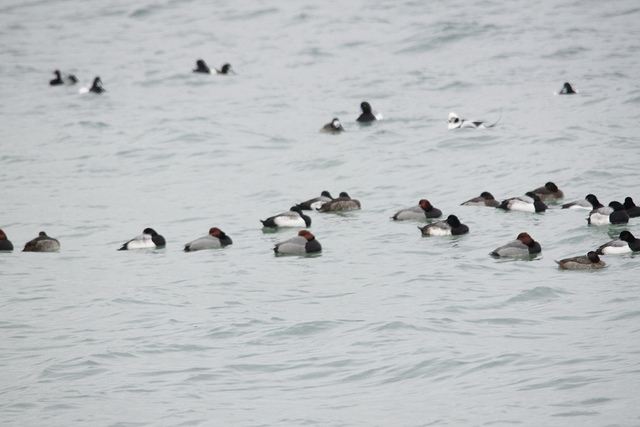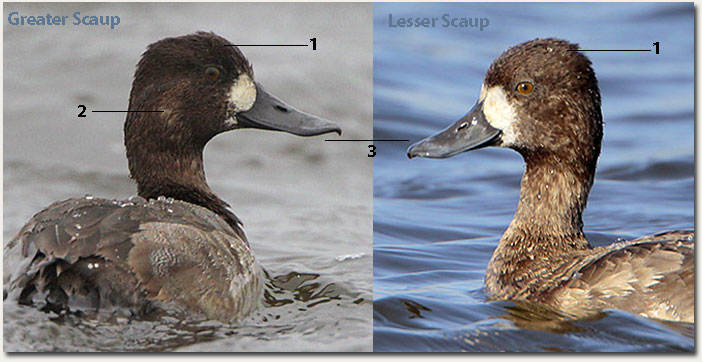
Separating Lesser Scaup vs Greater is a real challenge.
Some individual birds in certain postures can be relatively easy. Other individuals can be a greater challenge. Head shape is considered the key to separating the two species, but changes based on the activity, such as resting or diving (the wet head).
The color of the head is not generally a good field mark as it is variable based on lighting conditions. Take comfort in the fact that correctly picking a Greater Scaup out from a group of Lesser Scaup might be next to impossible. It takes a lot of experience and skill to correctly ID the less common Greater Scaup.
Lesser Scaup are more widespread and far more common in many parts of the country.
Lesser vs Greater Scaup: Female
- The peak of the crown on the Greater Scaup is toward the front of the head and over the eye. The peak of the head on the Lesser falls on the back of the head. Greater Scaup sometimes have the appearance of a flat spot on the head.
- Some female Greater Scaup may have a pale cheek patch in spring and summer. However, some female Lesser Scaup can have the same mark. Popular field guides vary in their description of this mark.
- The bill of the Lesser Scaup is slightly smaller than the Greater, but it is a very hard-to-use ID mark when in the field.
Below are two additional female scaups.
The bird on the left has a round-looking head (more Greater Scaup like) but no real peak to the crown. The bird on the right has a somewhat narrower-looking head but no real peak. The black nail on the bird on the right (tip of the bill) is narrow, perhaps indicating a Lesser Scaup.
Nail seems greatly reduced on the bird on the left, or perhaps not shown in the photograph. Compare with the head shape of the two above females. What do you think – greater vs lesser scaup?
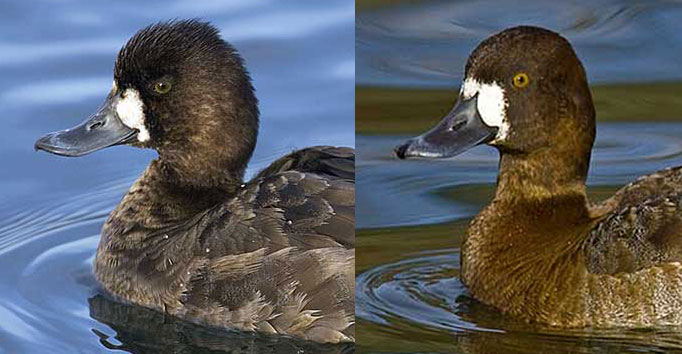
This ringer is a female Ring-necked Duck. The white at the base of the bill of a Ring-necked Duck can be very similar to the same area on a scaup. It is generally grayer on the Ring-necked Duck but can be whiter than this particular duck. Note the white eye ring and white band near the tip of the bill.
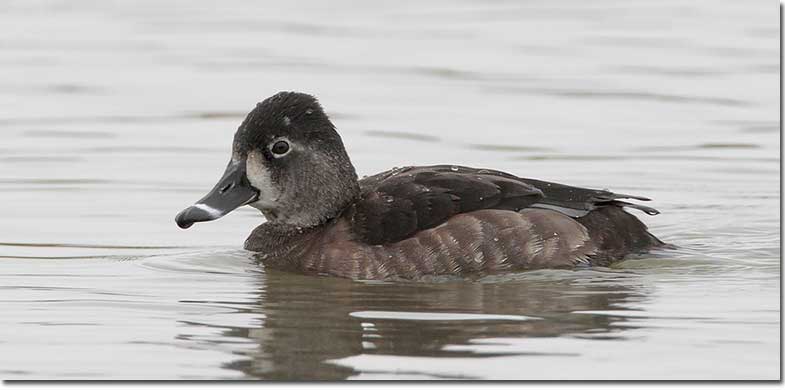
Male Scaup
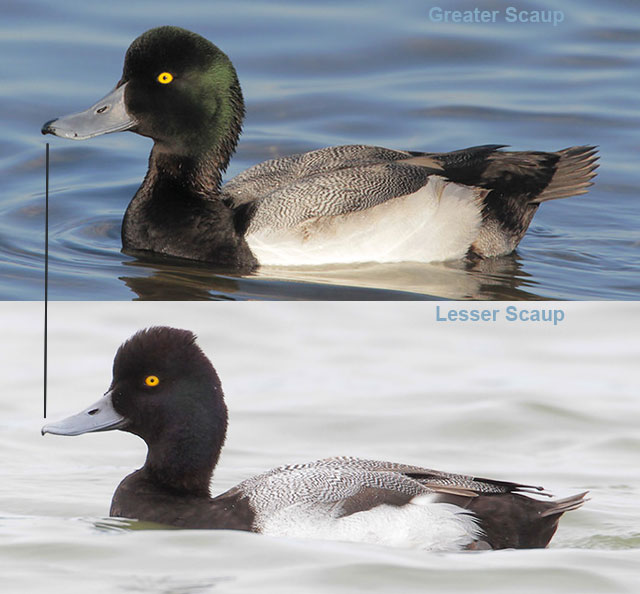
- The black tip of the bill on the Greater Scaup seems fairly wide.
- The peak of the crown on the Greater is toward the front of the head. The Lesser shows an almost small tuft near the back of the head, which can be seen on some males. The Greater shows a more rounded head appearance.
- The sides and back of the Greater average paler than the Lesser, but in these two birds the Lesser Scaup has a cleaner appearance, so use this mark with great discretion.
- Head color: Greater = Green is a rule some people use. However, depending on the lighting conditions this can be misleading. The head of the Lesser Scaup can also appear to have a greenish hue.
Facing the Front
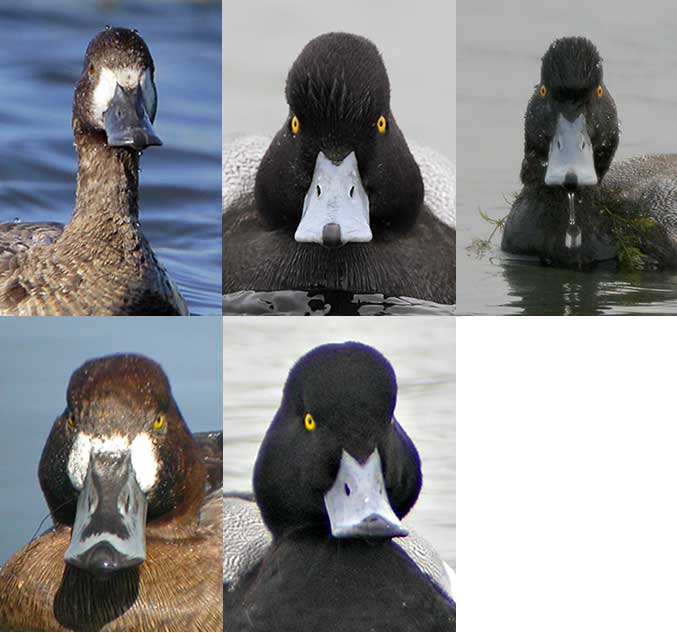
First row: Lesser Scaup © Greg Lavaty. Second Row – Greater Scaup © Len Blumin
When seen at this angle, Lesser Scaup tend to have a thinner, taller looking head but as can be seen in the middle image, they can also present a puffy-cheeked appearance.
The head of the Lesser Scaup can also appear to have a greenish hue.
Lesser Scaup are sometimes described as having a narrower, more straight-sided bill than the greater. Comparing the two center images it would be hard to say one bill has straighter edges or is more narrow than the other.
The wider black tip on the bill of the Greater Scaup is clearly visible and shows how variable the width can be.
In flight
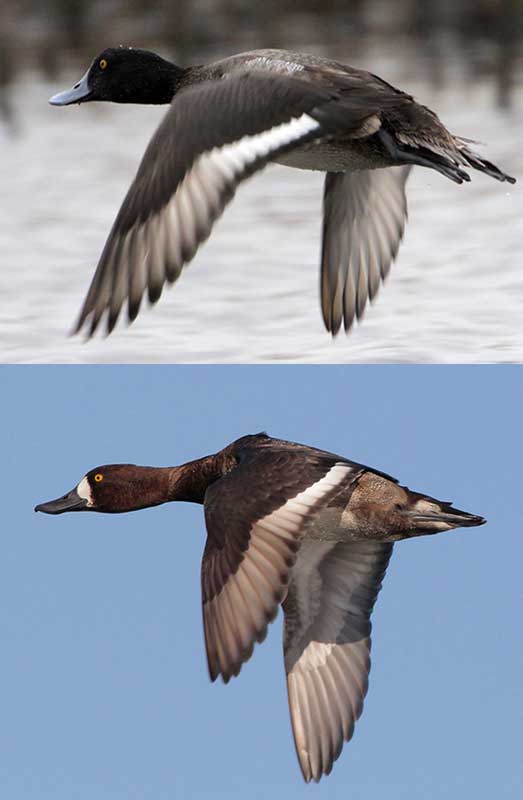
Great Scaup (top image) and Lesser Scaup (bottom image)
The Greater Scaup has more white in the wings than Lesser, but the difference can be minimal and hard to see when in flight. The shape of the head is more distinctive in these two images than the amount of white in the wings.
At Rest
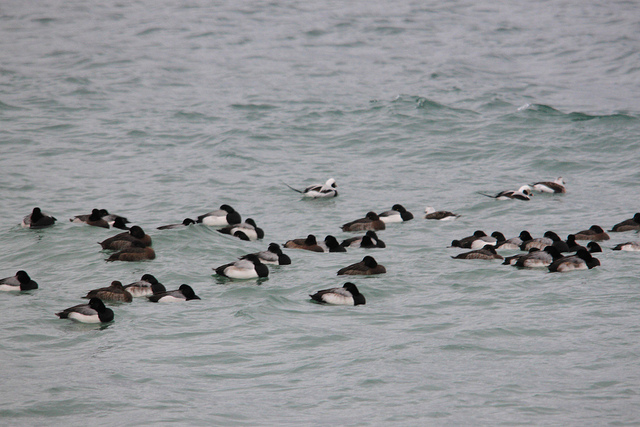
Flocks of scaup are often seen at rest, with their heads tucked in. When they are resting it is sometimes easier to see the more rounded head of the Greater Scaup compared to the peak on the back of the head of the Lesser Scaup. Some birds will be more obvious than others.
At least some of the sleeping ducks look like the peak of the head is toward the front of the head or have a flat appearance, indicating these are Greater Scaup. The birds in the back of this image are Long-tailed Ducks. Image from the Ontario Nature website.
Sleeping Redheads at a distance will present a similar color pattern but the sides and back are a more uniform gray.
